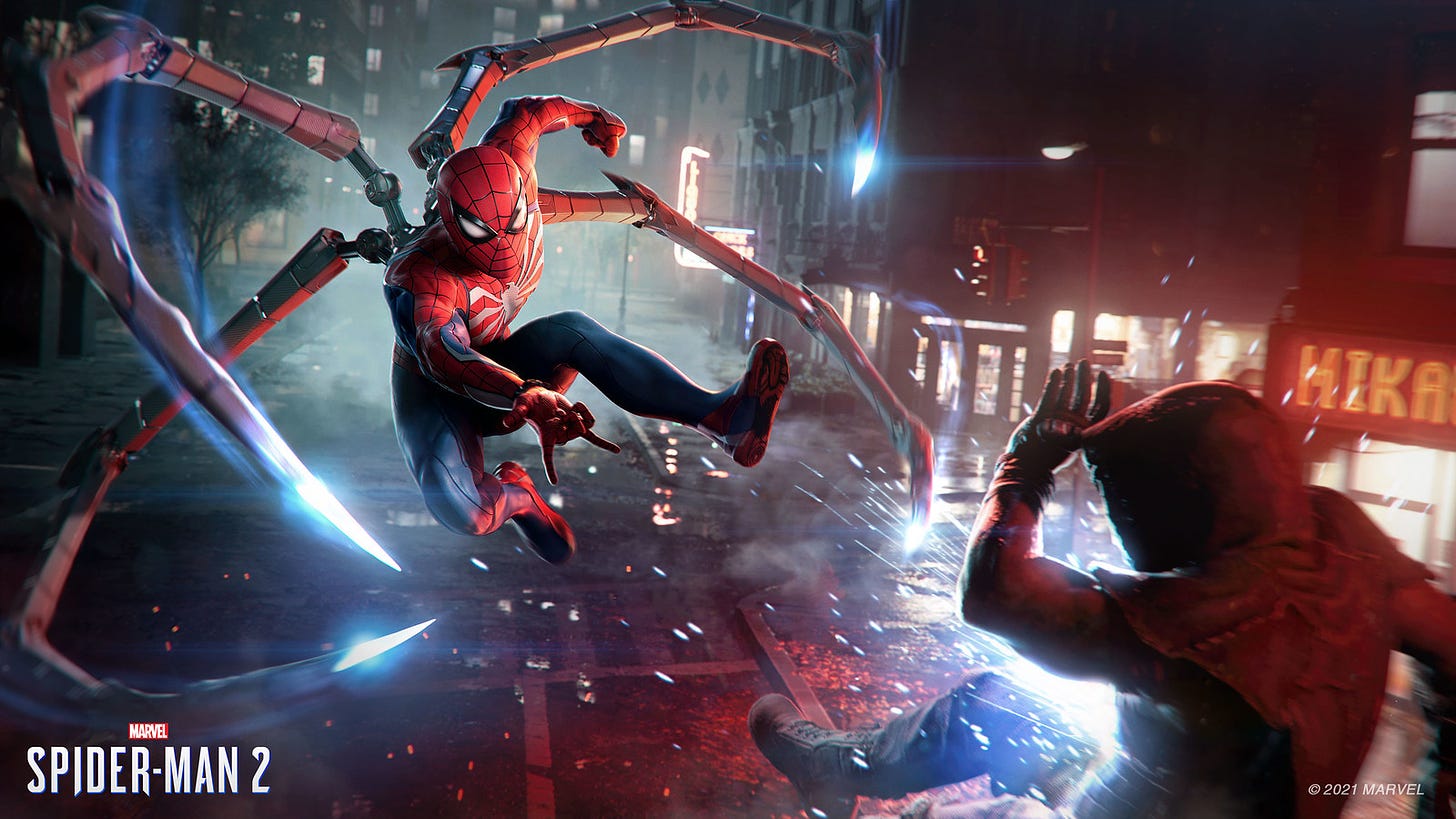EX is a research report about where culture is headed. You can learn more here. This week: true horror awakens on the app store.
1. A weekend’s worth of YouTube horror
The found footage genre has always been about stripping away studio conventions to create the illusion of something raw and real. First that meant handheld camerawork and documentaries (Cannibal Holocaust, The Blair Witch Project), but later it meant surveillance cams (Paranormal Activity), YouTubers (Gonjiam: Haunted Asylum), Zoom calls (Host), and streamers (Deadstream). (You could argue that the best FF movies were always about TV crews, like the BBC Halloween classic Ghostwatch, [REC], and the underseen Senritsu Kaiki File Kowasugi movies.) There’s a visible guardrail in place, though, when you experience these things in a theater or pick them out among Hollywood fare on Netflix. There can be a little added kick to finding horror on YouTube—even today’s professionalized, ad-friendly platform—as it still remains faintly plausible that you could stumble upon something really unknown and unsafe.
You can find many analog horror droners on YouTube, but one towers over the rest: “My house walk-through,” a 2016 short from Japanese artist PiroPito. (The making-of video is an essential follow-up.) It’s hard to find anything that matches its tone and especially its color palette. But if you’re looking to fill out a Halloween watchlist, there’s also solid stuff on the channel “Fake Documentary Q,” including the marching-ants texture VHS trip “The Visit.” Alan Resnick’s increasingly wild “alantutorial” series is a 2011 landmark that helped establish that the root of all YouTube horror is seeing someone’s messy room; his Adult Swim follow-ups “Unedited Footage of a Bear” and “This House Has People in It” are even better. Finally, fans of divisive art-horror Skinamarink should check out the director’s 30-minute “Heck,” which is similarly entrancing/boring.
If you’re looking for something feature-length to watch this weekend, Horror in the High Desert 2 has video-store-horror-guy buzz and new (non-FF) Shudder release When Evil Lurks has been called “actually good” and “the meanest horror movie I’ve ever seen.” And of course, there’s always the Senritsu Kaiki series, which is too scary to stream anywhere: you have to turn the lights out and pirate them.
2. Silent Hill returns as what fans wanted most: an app
Konami owns some of the most beloved series in games — Castlevania, Metal Gear Solid, Contra — but the beleaguered company has traditionally had a hard time knowing what to do with them. Last year they relaunched the dormant Silent Hill franchise with not one but four new games, all by very different developers. The first of them, subtitled Ascension, debuts on Halloween night, and it’s a doozy: a live-broadcast show rendered in-game that audiences play collectively, performing quick-time button presses and choosing between narrative options live. Develop Genvid claims new scenes will be available via bespoke mobile apps every day for “longer than a season of Fortnite,” with the creative team rushing to write new content daily based on the decisions of players the previous night.
It’s like Uber but for psychosexual nightmare melodrama. Players who miss scenes can watch weekly synopses on the Sony Bravia app, which, sheesh, no one is doing that. Much of the talk feels very David Cage — “any character can die, permanently” — which doesn’t exactly bode well for people who have played David Cage games before. But it is all legitimately strange, particularly in its delivery mechanisms, which is its own sort of chaotic good in the conservative world of major-publisher IP management.
3. Dungeon Hunter VI x Nickelback is real
What unholy marketing Tinder could have brought about the congress of Dungeon Hunter VI and Nickelback? One, a mobile Diablo forged in microtransaction hell; the other, an old dented can of drive-time rock. The most horrible thought is that the crossover could be a win-win: Nickelback leads their older audience into the whale traps of DHVI, and DHVI gets its army of clickers to microdose Nickelback songs for daily rewards. Mobile channel Chupper Gaming reports that you can earn 100 blue diamonds for each 15-second preview of a Nickelback song you ingest.
4. Death Grips fans blame zoomers for recent walk-off
A clip from a recent Death Grips show in Arkansas ignited discourse about show etiquette, zoomer behavior, and the band's storied history of internet fame. The clip depicts the band cutting their set early and leaving the stage after members of the audience threw glow sticks and water bottles at the performers. Other Death Grips concertgoers have reported seeing audience members intentionally piss in the moshpit, likely as a reference to in-jokes on the r/deathgrips subreddit. Commenters have since struggled to come to a consensus on who's to blame; some blame TikTok, some blame COVID, and still others blame "memerlords" who show up to concerts in suspenders and propeller beanies (another reference to a series of memes propagated on sites like Reddit and, increasingly, IRL). The near-universal suggestion, however, seems to be that the kids are not, in fact, all right — in other words, that zoomers who discovered the band on TikTok have poisoned the well.
It's easy to blame Gen Z for things like this if you're a disgruntled Death Grips fan. But it's tough to claim any of this with certainty, especially in the absence of any hard data. After all, any true head would remember that time in 2013 when they canceled a Lollapalooza event after receiving a suicide note over email. The audience was hardly gracious in response; after realizing Death Grips wouldn't be showing up, they became so enraged that they stormed the stage to destroy Zach Hill's drum kit. This is also the band that self-leaked a record and put an erect penis on the cover immediately after signing a major deal with Epic. MC Ride, the band's vocalist, is a notoriously private person, and has always avoided press and interactions with fans. Regardless of whether or not audiences have truly become more intolerable as the years have passed, Death Grips' unshakeable resolve has remained the same: If they're gonna make music, they're gonna make it on their own terms. Otherwise, they're packing up and leaving.
5. Puzzmo is the cute, designer-y alternative to NYT puzzles
Mobile gaming may be the highest calling of the smartphone, but anyone who has ever tried to knuckle down on, say, a touchscreen version of Resident Evil knows that the platform deserves its own game types. The New York Times figured this out quickly, drawing a million customers into its premium games product and purchasing the phenom Wordle in 2022 as part of its broader strategy to reduce seasonality in hard-news readership. Hearst publishing is playing a bit of catchup, but their new Puzzmo platform is a delightfully strange offering, centralizing the game designers (who write introductory notes for each game), a sense of exclusivity (players must be one of the first 500 people to beat a game each day to get access to the next day’s games), and tactility (they are mailing physical copies of games to people, as well?). Puzzmo is the brainchild of indie-game wunderkind Zach Gage, who has masterpieces like SpellTower and Ridiculous Fishing to his credit, as well as a slate of games for Apple Arcade — a service which has similarly forged its own path after abandoning the “hardcore gamer” early in its lifecycle. Puzzmo isn’t yet its own app, but rather its own brand of genteel gaming born from the market the Times helped create. Nevertheless, Gage is an iconoclastic and sometimes very funny designer, so Puzzmo’s evolution should at least be interesting.
6. Ka stays analog
The gnomic, wildly influential indie rapper Ka has made his name doing things his way — each record is its own self-contained cosmos, produced and art-directed entirely by the Brownsville native (and, controversially, full-time firefighter). Apparently he had also been manually packing and shipping all merchandise bought from his store, a process that had grown too time-consuming to maintain single-handedly, so rather than hire literally anyone to help him he sold all his stock at a pop-up shop in New York. Fans lined up around the block to fist-bump the living legend and fork over $100 a pop for vinyl LPs, which are already selling at 700% markup online. If you are new to the rapper’s output, check his pair of typically austere 2022 records Languish Arts and Woeful Studies, for a primer. They’ll grow on you.
7. Let’s hear it for “dancing characters” in fighting games
Tekken 8’s Azucena became the breakout star of the game’s last beta test thanks to some fancy footwork. This makes her the latest dancing character to fascinate the fighting game community: she was preceded in Tekken by the idol Lucky Chloe and button-mash king Eddy Gordo. Almost every Japanese fighting game franchise has its own dancing characters: Elena, Dee Jay, and Manon in Street Fighter, Anji in Guilty Gear, Duck King in King of Fighters, and groaning S&M freak Voldo from Soul Calibur. Maybe dancers are simply fun to play, as they’re always taunting opponents with their movement; or maybe dancing is just a natural extension of the bouncing and shuffling in place that fighting game characters do when left idle on the screen.
8. The web-slinging tryhard
YouTuber @C0LIN posted a Spider-Man 2 tweet attempting to show off what they called "the greatest traversal system in gaming." It backfired, however, as commenters accused them of "tryharding" (i.e., playing in an excessively performative way). One commenter described C0LIN's gameplay as "Modern Warfare ahh spiderman movement" (watch this clip for an example of what they mean), while another dismissed it as "spamming buttons."
The commenters are right. While gameplay footage like C0LIN's might be impressive to an outside observer, anyone who's played Spider-Man 2 or either of its predecessors knows that the game seamlessly links animations together in a way that can make any player feel adept at web-slinging. As a result, subtle tells — like starting and cancelling glider animations over and over or swiveling the camera in a manic, unfocused way — become giveaways that you're watching a tryhard at work.
9. Life imitates art; art imitates mobile game ads
As Tolstoy wrote, “all happy TV Man families are alike; each unhappy TV Man family is unhappy in its own way.” For proof, look no further than the YouTube Short "TV Man's happy family," starring the TV-headed protagonists of the Skibidi Toilet universe. The TV Man and TV Woman spurn their suitors, represented by a Titan Speakerwoman and a Skibidi Toilet, respectively. The Short concludes with a moral about being faithful to one's spouse to ensure a stable future for one's child.
This Short takes most of its visual inspiration from mobile game ads, which have developed a distinct symbolic language that’s now matriculated to the greater gaming landscape. Instead of showcasing actual gameplay, mobile game ads often depict people (mostly women) stuck in crude and dangerous situations, prompting the viewer to make a decision about whether and/or how to rescue them. These ads have become so ubiquitous that YouTubers have begun turning them into opportunities for content. As a result, the "fake mobile game ad" has become a narrative format unto itself, giving rise to Skibidi-style mutations like this one.
YouTube Thumbnail of the Week

Chum Box
Gandalf is a little game made to demonstrate methods of jailbreaking LLMs like ChatGPT or Bing Image Creator. Jailbreaks are an increasingly big deal to companies with serious AI investments: Microsoft pays a bounty of up to $15K for good ones.
Here’s an unforgettable Letterboxd review of The Super Mario Bros. Movie (via @eventualforever).
Indie developer David Szymanski updated his horror game Iron Lung to add cheats and “Markiplier Mode.”
The corpse of Halo Infinite may be returning to life thanks to a fan-pleasing new season and enthusiasm for a user-made Battle Royale mode.
Tumblr users argued whether this tune was “bloopin music” or “toad music.” But is it really an older genre in disguise?
A Twitter thread kicked up the argument about whether or not the present usage of the phrase “oh you sweet summer child” can be credited to George R.R. Martin. EX is at war with itself over this story and presents it here with no additional commentary.
Costco will dump 157 pieces of red high-end Le Creuset cookware at your front doorstep if you cough up $4500.
A new “data poisoning tool” promises not only to protect artists’ work from getting scraped by AI companies, but also to corrupt image-generating AI models themselves, rendering them less effective at making associations between words and imagery.
Japanese Drift Master was a surprise hit during Steam Next Fest, garnering the second largest amount of demo downloads during the event.
“Did anyone ever set The Irishman’s ending to ‘What I’ve Done’ by Linkin Park?”
That’s it for this week. We’ll be spending the weekend recovering from the Nickelback jumpscare.







